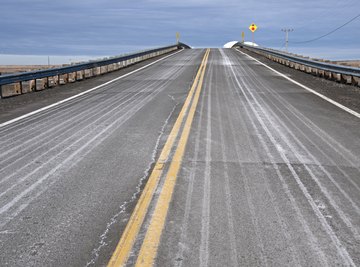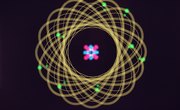
There's much more to compounds than meets the eye. They are chemical bonds based on attraction. Allowing you to grasp the very nature of this chemical process, shell models visually represent a bond that can only be seen at the molecular level. The calcium chloride shell model exposes the chemical process that occurs when this compound is formed from an ionic bond between calcium and chloride. Calcium chloride is also known as CaCl2 in scientific notation.
Draw a Chlorine Atom
Mentally divide the paper into four equal quadrants. You will draw two atoms on the top of the page, and three on the bottom.
Draw a nickel-size circle in the center of the upper left quadrant. This circle represents the nucleus. Measure 1/2 inch from the edge of the nucleus and draw three concentric circles progressively larger. The circles should all be 1/2 inch apart.
Imagine the drawing is a clock face. The nucleus is the center, up and down are 12 and 6 o'clock, and the sides are 3 and 9 o'clock.
Draw a dot on the first through third rings at the 12 o'clock position. Do the same for the 6 o'clock position.
Add a dot to the outside two rings at the 9 o'clock position.
Add one dot on the center ring at the 3 o'clock position.
Place one dot on the outer two rings at the 1, 5, 7 and 11 o'clock positions. Color all dots green.
Draw a Calcium Atom
Draw a nickel-size circle centered between the upper left and upper right quadrants. Measure 1/2 inch from the edge of this dot, which represents the nucleus, and draw four concentric circles progressively larger. As with chlorine, all circles should be 1/2 inch apart.
Draw a dot on the first through third rings at the 6 and 12 o'clock positions.
Draw one dot at the 3 and 9 o'clock positions starting at the second ring and ending on the fourth.
Draw one dot on the second and third rings at the 1, 5, 7 and 11 o'clock positions. Color all dots red.
Draw the Bottom Atoms
- Cardstock
- Pencil
- Ruler
- Black Marker
- Green Marker
- Red Marker
Redraw the chlorine atom in the bottom left quadrant. Do not color any dots with marker yet.
Draw another calcium atom beneath the first one, and centered on the bottom of the page.
Draw another chlorine atom in the bottom right quadrant.
Remove one dot from the bottom calcium atom’s outside ring at the 9 o'clock position. Draw another dot on the outside ring of the chlorine atom on the left. Place it in the 3 o'clock position.
Draw an arrow that indicates the dot has moved from the calcium to the chloride. Color the moved dot red. Color all of the other dots in that chlorine atom green.
Erase another dot from the calcium atom’s outside ring at the 3 o'clock position. Draw another dot on the outside ring of the chlorine atom on the right. Place it in the 9 o'clock position. Color it red. Color the other chlorine dots green.
Color the remaining calcium dots red.
Things You'll Need
References
About the Author
Susan Elliott teaches studio art and creative writing to home schooled students. She is a graduate of Northwest Arkansas Community College and the Memphis School of Preaching Student Wives Program. She has written for Christian Woman Magazine and Virtuous Magazine. When she's not writing, she is painting or making costumes.
Photo Credits
Phil Augustavo/iStock/Getty Images
